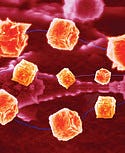March 1, 2009
R&D Digest
|
A nanosized tetherball design is key to a biosensor built by engineers at Purdue University. Through its use of single-wall carbon nanotubes anchored to gold-coated nanocubes, the device can detect blood glucose.
Timothy Fisher, professor of mechanical engineering at Purdue University, says that the device is composed of sensors that resemble miniature cube-shaped tetherballs. A nanotube connects each tetherball to electronic circuitry. By conducting electrical signals, the nanotube performs something like a tether and an ultrathin wire. The diameter of the nanotubes is “roughly 25,000 times thinner than a human hair,” according to the Purdue News Service.
The tetherball design is suitable for sensing applications because the sensing portion of the system stretches out from the rest of the device. This allows the tetherball to come into contact with other molecules, Fisher says, without having to wait for target molecules to diffuse down to the surface. The cubes can also use the range of the tether to move into other regions for further sensing.
To prove that biological molecules stick specifically to the cubes, engineers attached the protein combination of streptavidin and biotin onto the gold-coated nanocubes (gold is compatible with biological molecules). After demonstrating that molecules attach to the tetherball—and not to all materials—the researchers transformed the device into a glucose sensor. They replaced the biotin with glucose oxidase, an enzyme that triggers an electrochemical reaction in the presence of glucose and oxygen.
One obvious use for this device is its incorporation into a catheter that continuously monitors blood glucose for diabetics, says Marshall Porterfield, associate professor of agriculture and biological engineering at Purdue. The components for this biosensor were assembled from the atomic to biomolecular level. This “changes the transport kinetics that limit bulk nanomaterial application biosensors,” Porterfield says, “so as to improve the lower detection limit, while exceeding the linear range.”
According to the researchers, the technology detects glucose more precisely than any other biosensor in development, because other sensors require “at least five times more glucose to generate a signal.” In addition, the biosensor also operates over a wide range of glucose concentration. Fisher says this is significant because there are different levels of glucose concentration in the arteries than there is in the small intestines or muscles. The combined characteristics of sensing small quantities and detecting a wide range of concentrations are rare for sensors. Fisher says that these abilities could make the biosensor adaptable as an “all-purpose sensor platform.”
The system could also be used to study the brain and nervous system. Porterfield says that by replacing the glucose oxidase enzyme used to detect glucose with an enzyme associated with neuronal signaling, scientists might gain a better understanding of some diseases.
The device is also suitable for electronic sensors because electricity flows efficiently through wires with small diameters. The engineers have developed a way to grow individual carbon nanotubes on top of a silicon wafer. They say this could lead to the use of nanotubes in advanced electronics, wireless devices, and sensors.
Graduate research assistant Jonathan Claussen also contributed to this project. The researchers have filed a patent application for the system. Their biosensor was profiled in the January issue of the American Chemical Society journal, ACS Nano.
Copyright ©2009 Medical Device & Diagnostic Industry
About the Author(s)
You May Also Like



